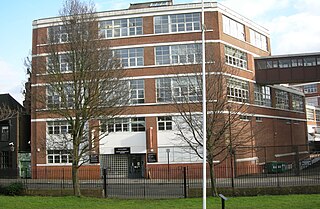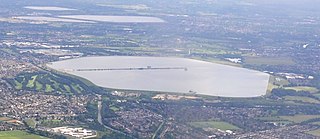
Middlesex is a historic county in southeast England. Its area is almost entirely within the wider urbanised area of London and mostly within the ceremonial county of Greater London, with small sections in neighbouring ceremonial counties. Three rivers provide most of the county's boundaries; the Thames in the south, the Lea to the east and the Colne to the west. A line of hills forms the northern boundary with Hertfordshire.

The home counties are the counties of England that surround London. The counties are not precisely defined but Berkshire, Buckinghamshire, Essex, Hertfordshire, Kent and Surrey are usually included in definitions as they directly border London. Other counties slightly further from London – such as Bedfordshire, Cambridgeshire, Hampshire, Oxfordshire, East Sussex and West Sussex – are not always regarded as home counties, although on occasion may be thought of as such due to their proximity to London and their connection to the London regional economy.

The County of London was a county of England from 1889 to 1965, corresponding to the area known today as Inner London. It was created as part of the general introduction of elected county government in England, by way of the Local Government Act 1888. The Act created an administrative County of London, which included within its territory the City of London. However, the City of London and the County of London formed separate ceremonial counties for "non-administrative" purposes. The local authority for the county was the London County Council (LCC), which initially performed only a limited range of functions, but gained further powers during its 76-year existence. The LCC provided very few services within the City of London, where the ancient Corporation monopolised local governance. In 1900, the lower-tier civil parishes and district boards were replaced with 28 new metropolitan boroughs. The territory of the county was 74,903 acres (303.12 km2) in 1961. During its existence, there was a long-term decline in population as more residents moved into the outer suburbs; there were periodic reviews of the local government structures in the greater London area and several failed attempts to expand the boundaries of the county. In 1965, the London Government Act 1963 replaced the county with the much larger Greater London administrative area.

The London Metropolitan Archives (LMA) is the principal local government archive repository for the Greater London area, including the City of London: it is the largest county record office in the United Kingdom. It was established under its present name in 1997, having previously been known as the Greater London Record Office. It is administered and financed by the City of London Corporation.
The utility infrastructure of London, England comprises a range of services and facilities that support and enable the functioning of London as a world city. Infrastructure includes facilities associated with products and materials that are consumed such as electricity, gas, water, heating and liquid fuels; materials that are produced such as sewage and solid waste; and facilities that enable communication and connectivity – telecommunications.

The William Girling Reservoir is located in the London Borough of Enfield and is part of the Lee Valley Reservoir Chain that supplies London with drinking water. It is named after William Girling OBE, a chairman of the Metropolitan Water Board (MWB). The reservoir and the nearby King George V Reservoir are known collectively as the Chingford Reservoirs. The storage reservoir, which is owned by Thames Water, is bordered by Chingford to the east and Ponders End and Edmonton to the west, and covers 334 acres with a perimeter of 3.5 miles (5.6 km). There is no public access.

The Staines Reservoirs are two large pumped storage reservoirs sitting to the east of the King George VI Reservoir near Heathrow airport in Surrey within the Colne Valley regional park. The village of Stanwell is mainly to the north east, and the town of Staines is to the south.

The Queen Mary Reservoir is one of the largest of London's reservoirs supplying fresh water to London and parts of surrounding counties, and is located in the Borough of Spelthorne in Surrey. The reservoir covers 707 acres (2.86 km2) and is 45 ft (14 m) above the surrounding area.

The Bessborough Reservoir is an embanked storage reservoir south of the River Thames in Surrey adjacent to the Knight Reservoir. To the south lies Queen Elizabeth II Reservoir and to the north the now disused Molesey Reservoirs. The A3050 runs to the north of the reservoir and the neighbouring town is Molesey to the east. It forms part the green buffer between Molesey and Walton on Thames. The reservoir is in the borough of Elmbridge.

The Knight Reservoir is a large pumped storage reservoir located in the Borough of Elmbridge in Surrey. It was inaugurated in 1907 and stores up to 2,180 million litres of raw water abstracted from the River Thames prior to its treatment and supply to London and north Surrey. It is located south of the River Thames, west of West Molesey, and between Hurst Road (A3050) and Walton Road (B369). It is adjacent to, and west of, its twin Bessborough Reservoir.

London's water supply infrastructure has developed over the centuries in line with the expansion of London.

The Chelsea Waterworks Company was a London waterworks company founded in 1723 which supplied water to many central London locations throughout the 18th and 19th centuries until its functions were taken over by the Metropolitan Water Board in 1904.

The East London Waterworks Company was one of eight private water companies in London absorbed by the Metropolitan Water Board in 1904.
The Southwark and Vauxhall Waterworks Company was a utility company supplying water to parts of south London in England. The company was formed by the merger of the Southwark and Vauxhall water companies in 1845 and became part of the publicly owned Metropolitan Water Board in 1904.
The Grand Junction Waterworks Company was a utility company supplying water to parts of west London in England. The company was formed as an offshoot of the Grand Junction Canal Company in 1811 and became part of the publicly owned Metropolitan Water Board in 1904.
The West Middlesex Waterworks Company was a utility company supplying water to parts of west London in England. The company was established in 1806 with works at Hammersmith and became part of the publicly owned Metropolitan Water Board in 1904.

The Colne Valley Water Company was a statutory water company, formed in 1873. For a hundred years its water supply was obtained from underground sources accessed by boreholes. Pressure on these resources led to the Three Valleys Scheme and the construction of nine miles of trunk main from the River Thames was completed in 1974. In 1994, Colne Valley merged with the other two companies in the Scheme, the Rickmansworth and Lee Valley Water companies, to form Three Valleys Water plc. That in turn was acquired by Veolia Water in 1987.

Cricklewood Pumping Station was built in 1905 to supply water to London's north west suburbs. It is situated at the eastern extremity of Gladstone Park, Cricklewood and is a locally listed building.
Essex and Suffolk Water is a water supply company in the United Kingdom. It operates in two geographically distinct areas, one serving parts of Norfolk and Suffolk, and the other serving parts of Essex and Greater London. The total population served is 1.8 million. Essex and Suffolk is a 'water only' supplier, with sewerage services provided by Anglian Water and Thames Water within its areas of supply. It is part of the Northumbrian Water Group.
Surrey Street Pumping Station is a Grade II listed pumphouse in Croydon, South London, England, that was built in four phases. It is the site of a well that "had been more or less public ever since the town existed". It was opened by the Archbishop of Canterbury on 11 December 1851, making Croydon one of the first towns to have a combined water and sewage system under the Public Health Act 1848, and to Chadwick’s arterial-venous design. The water was pumped from the wells, up Park Hill to a cylindrical brick reservoir with a domed roof to provide a constant supply of fresh piped water. Prior to its opening, the inhabitants of Croydon used the river Wandle, streams and shallow wells, which were often contaminated by seepage from privies and cesspools. Parts of Norwood were served with water from the Lambeth Water Company, a private company established by an act of parliament in 1785.















